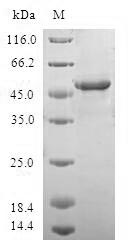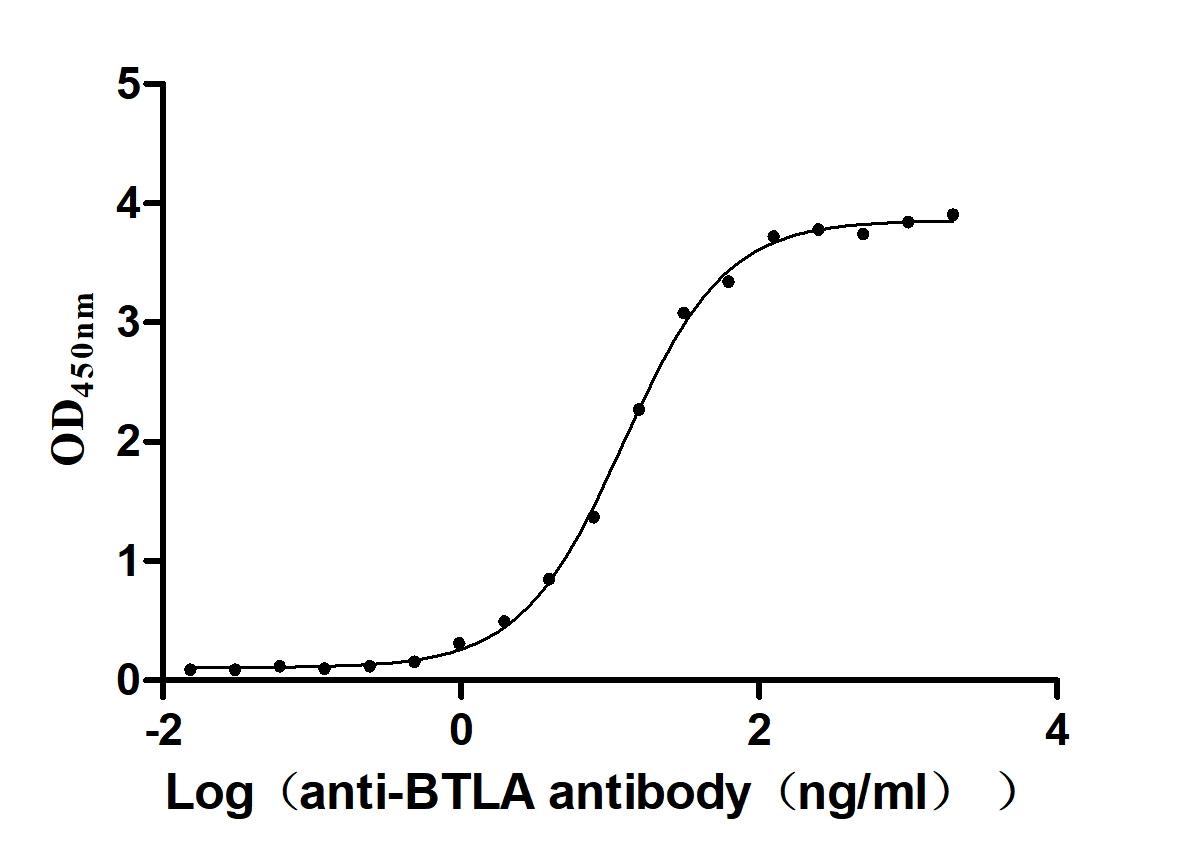Recombinant Human CCN family member 5 (CCN5)
-
货号:CSB-EP026120HU(A4)
-
规格:¥1344
-
图片:
-
其他:
产品详情
-
纯度:Greater than 90% as determined by SDS-PAGE.
-
基因名:CCN5
-
Uniprot No.:
-
别名:CCN family member 5; CCN5 ; Connective tissue growth factor like protein; Connective tissue growth factor related protein 58 ; Connective tissue growth factor-like protein; Connective tissue growth factor-related protein 58; CT58 ; CTGF L; CTGF-L; WISP 2; WISP-2; Wisp2; WISP2_HUMAN; Wnt 1 signaling pathway protein 2; WNT1 inducible signaling pathway protein 2; WNT1-inducible-signaling pathway protein 2
-
种属:Homo sapiens (Human)
-
蛋白长度:Full Length
-
来源:E.coli
-
分子量:51.3kDa
-
表达区域:1-250aa
-
氨基酸序列MRGTPKTHLLAFSLLCLLSKVRTQLCPTPCTCPWPPPRCPLGVPLVLDGCGCCRVCARRLGEPCDQLHVCDASQGLVCQPGAGPGGRGALCLLAEDDSSCEVNGRLYREGETFQPHCSIRCRCEDGGFTCVPLCSEDVRLPSWDCPHPRRVEVLGKCCPEWVCGQGGGLGTQPLPAQGPQFSGLVSSLPPGVPCPEWSTAWGPCSTTCGLGMATRVSNQNRFCRLETQRRLCLSRPCPPSRGRSPQNSAF
Note: The complete sequence including tag sequence, target protein sequence and linker sequence could be provided upon request. -
蛋白标签:N-terminal GST-tagged
-
产品提供形式:Liquid or Lyophilized powder
Note: We will preferentially ship the format that we have in stock, however, if you have any special requirement for the format, please remark your requirement when placing the order, we will prepare according to your demand. -
缓冲液:Tris-based buffer,50% glycerol
-
储存条件:Store at -20°C/-80°C upon receipt, aliquoting is necessary for mutiple use. Avoid repeated freeze-thaw cycles.
-
保质期:The shelf life is related to many factors, storage state, buffer ingredients, storage temperature and the stability of the protein itself.
Generally, the shelf life of liquid form is 6 months at -20°C/-80°C. The shelf life of lyophilized form is 12 months at -20°C/-80°C. -
货期:Basically, we can dispatch the products out in 1-3 working days after receiving your orders. Delivery time may differ from different purchasing way or location, please kindly consult your local distributors for specific delivery time.Note: All of our proteins are default shipped with normal blue ice packs, if you request to ship with dry ice, please communicate with us in advance and extra fees will be charged.
-
注意事项:Repeated freezing and thawing is not recommended. Store working aliquots at 4°C for up to one week.
-
Datasheet & COA:Please contact us to get it.
相关产品
靶点详情
-
功能:May play an important role in modulating bone turnover. Promotes the adhesion of osteoblast cells and inhibits the binding of fibrinogen to integrin receptors. In addition, inhibits osteocalcin production.
-
基因功能参考文献:
- The s show that, in triple-negative-breast cancer (TNBC) cells enriched with tumor initiating cells, CCN5 significantly blocks cellular growth via apoptosis, reversing epithelial-mesenchymal-transition-signaling and impairing mammosphere formation, thereby blocking the tumor-forming ability and invasive capacity of these cells. PMID: 28450698
- by analyzing different estrogen receptor-alpha(ER-a)-positive and ER-a-negative breast cancer cell lines, we defined the role of CCN5 in the leptin-mediated regulation of growth and invasive capacity. PMID: 29370782
- CCN3 (Nov) and CCN5 (WISP2) are novel substrates of MMP14. PMID: 27471094
- Results show that WISP2 and beta-catenin were more highly expressed in gastric cancer tissues and seem to correlate with early stage or without metastasis. PMID: 28739741
- Report opposing effects of CCN2 and CCN5 on fibroblast proliferation and transdifferentiation induced by TGF-beta. PMID: 26218313
- Serum WISP2 correlated directly with fatty acid binding protein 4. Serum SFRP5 did not differ between obese (n=32) vs. nonobese (n=25) PCOS women, but reference women had lower SFRP5 (p<5x10(-6) as compared to both PCOS groups). PMID: 25089371
- Activation of CCN5 may have the therapeutic potential to kill triple-negative breast cancer. PMID: 25132260
- WISP2 has a role in regulating tumor cell susceptibility through EMT by inducing the TGF-beta signaling pathway, KLF-4 expression and miR-7 inhibition. PMID: 24931170
- The obtained results indicate that the changes in gene expression in bone marrow progenitor cells can be involved into space flight-induced osteopenia. PMID: 25509878
- overexpression of FGFBP1 or loss of WISP-2 expression is closely related to the metastasis, invasion and poor prognosis of gallbladder cancer. PMID: 23592278
- Loss of WISP2 in estrogen-dependent MCF7 human breast cancer cells promotes a stem-like cell phenotype. PMID: 24498388
- We demonstrate that the overexpression of CCN5 in lung fibroblasts suppresses the upregulation in the expression of alpha-SMA and collagen induced by CCN2. PMID: 24276150
- WISP2 exerts dual actions in mesenchymal precursor cells; secreted WISP2 activates canonical WNT and maintains the cells in an undifferentiated state, whereas cytosolic WISP2 regulates adipogenic commitment. PMID: 24451367
- Regulation of invasion by WISP2 may involve the WNT signalling pathway. PMID: 23893926
- WISP2 regulates preadipocyte commitment and PPARgamma activation by BMP4. PMID: 23359679
- WISP2 gene expression is regulated both by obesity and by the region between visceral and subcutaneous adipose tissue. PMID: 22616691
- Studies suggest a novel regulatory pathway exists through which CCN5 exerts its anti-invasive function. PMID: 22020939
- CCN5 represses expression of genes associated with epithelial-mesenchymal transition (EMT) as well as expression of key components of the transforming growth factor beta (TGF-beta) signaling pathway. PMID: 21262769
- The CCN5/WISP2 were downregulated in paired comparisons of plexiform neurofibroma and malignant peripheral nerve sheath tumor. PMID: 20010302
- Overexpression of WISP2 is associated with breast cancer PMID: 11855747
- disruption of WISP-2 signaling by use of antisense oligomers caused a significant reduction in breast tumor cell proliferation PMID: 12659671
- WISP2 was overexpressed in gastrointestinal peptide-independent ACTH-independent macronodular adrenal hyperplasia. PMID: 14767469
- regulation of phosphorylation of ER-alpha and EGFR may play critical roles in EGF-induced transcriptional activation of WISP-2 gene in breast tumor cells PMID: 15798095
- These data demonstrate that the expression of WISP2 is synergistically upregulated in RA synovial fibroblasts by estrogen and WNT pathways, and suggest an involvement in the pathology of the disease. PMID: 16038875
- Results suggest that WISP-2 could be a reliable independent marker and that down-regulation or loss of the WISP-2 gene may be associated with the development of salivary gland tumors. PMID: 16525711
- WISP-2/CCN5 is a novel signaling molecule that critically participates in the mitogenic action of PMA on noninvasive, WISP-2/CCN5-positive breast tumor cells through PKCalpha-dependent, multiple molecular signal transduction pathways. PMID: 16939222
- Data suggest WISP-2/CCN5 silencing may be a critical event during differentiation and progression of pancreatic adenocarcinoma. PMID: 17383817
- WISP-2 had greater levels of expression in node-positive tumors; higher levels in both moderate and poor prognostic groups compared with the good prognostic group; greater level in both grade 2 and 3 when compared with grade 1. PMID: 17406949
- WISP-2/CCN5 is an important regulator involved in the maintenance of a differentiated phenotype in breast tumor epithelial cells and may play a role in tumor cell invasion and metastasis PMID: 18070926
- Loss of CCN5 is associated with gain of oncogenic function of p53 mutants invasiveness in breast cancer PMID: 18559502
- CCN5 mRNA and protein level was almost undetectable in poorly differentiated breast cancers compared with the moderately or well-differentiated samples and its expression inversely correlated with lymph node positivity. PMID: 18794149
显示更多
收起更多
-
亚细胞定位:Secreted.
-
蛋白家族:CCN family
-
组织特异性:Expressed in primary osteoblasts, fibroblasts, ovary, testes, and heart.
-
数据库链接:
HGNC: 12770
OMIM: 603399
KEGG: hsa:8839
STRING: 9606.ENSP00000190983
UniGene: Hs.592145
Most popular with customers
-
Recombinant Human Leukemia inhibitory factor (LIF) (Active)
Express system: Mammalian cell
Species: Homo sapiens (Human)
-
Recombinant Human T-cell surface protein tactile (CD96), partial (Active)
Express system: Mammalian cell
Species: Homo sapiens (Human)
-
Recombinant Human Cannabinoid receptor 1 (CNR1)-VLPs (Active)
Express system: Mammalian cell
Species: Homo sapiens (Human)
-
Recombinant Human Glucagon-like peptide 1 receptor (GLP1R), partial (Active)
Express system: Mammalian cell
Species: Homo sapiens (Human)
-
Recombinant Human Desmoglein-3 (DSG3), partial (Active)
Express system: Baculovirus
Species: Homo sapiens (Human)
-
Recombinant Human B- and T-lymphocyte attenuator(BTLA), partial (Active)
Express system: Mammalian cell
Species: Homo sapiens (Human)
-
Recombinant Macaca fascicularis Dipeptidase 3(DPEP3) (Active)
Express system: Mammalian cell
Species: Macaca fascicularis (Crab-eating macaque) (Cynomolgus monkey)
-
Recombinant Macaca fascicularis Interleukin 1 receptor accessory protein(IL1RAP), partial (Active)
Express system: Mammalian cell
Species: Macaca fascicularis (Crab-eating macaque) (Cynomolgus monkey)




-AC1.jpg)
















